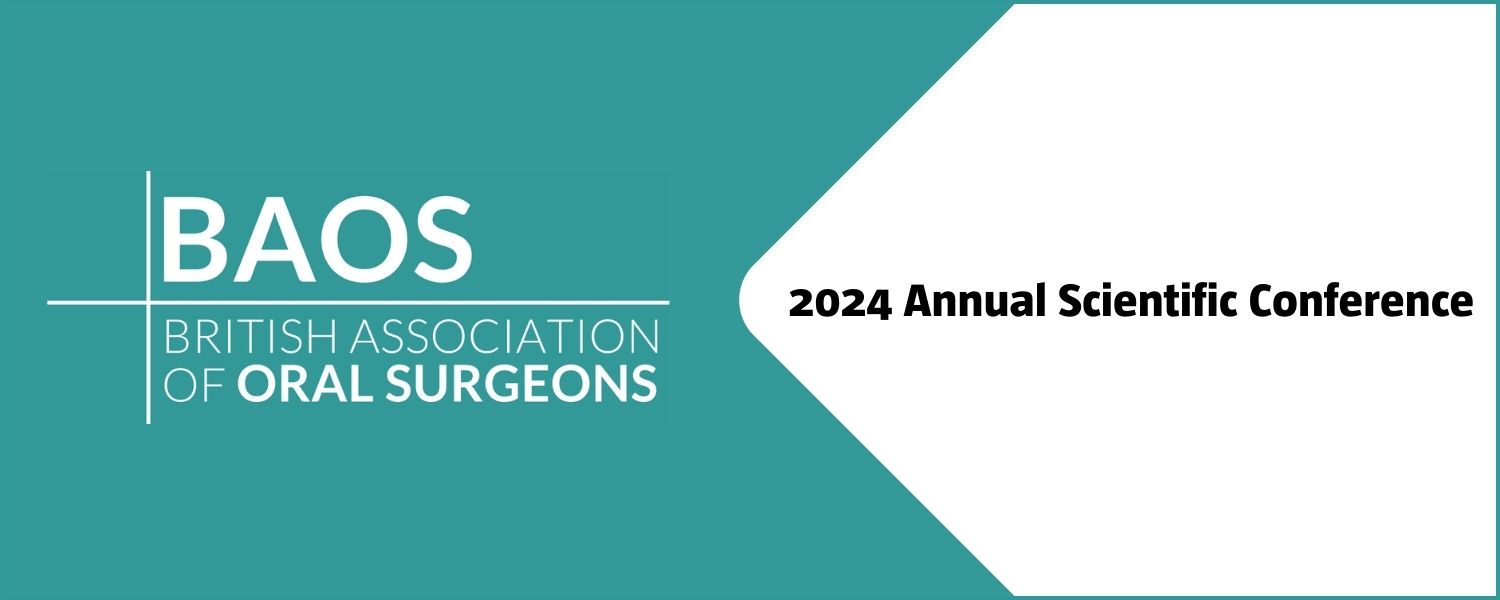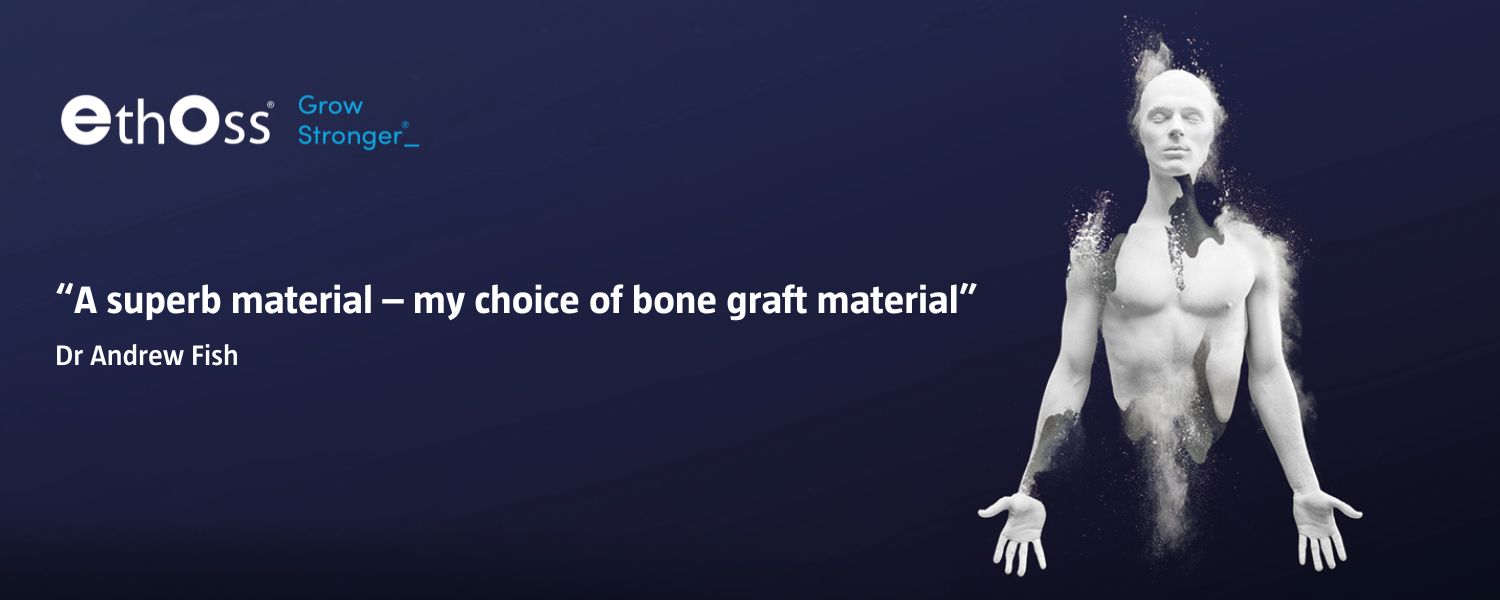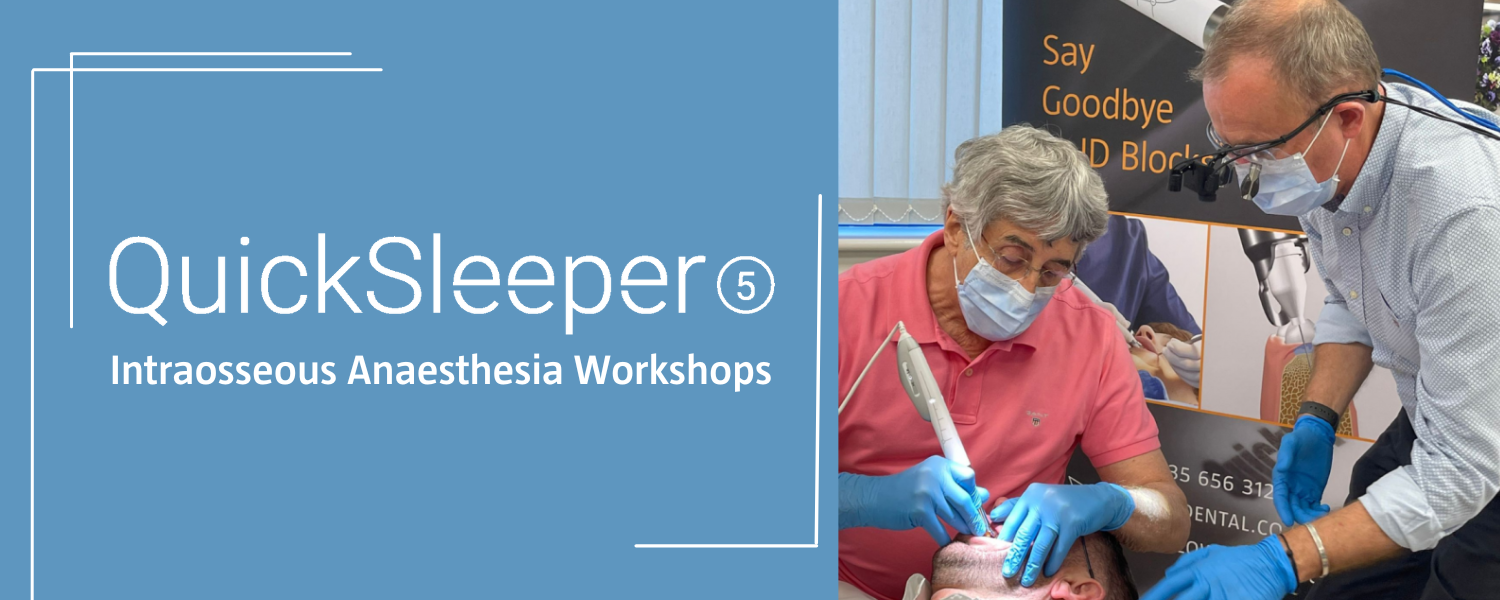"Incredibly Reliable" - My Experience Using EthOss
Having worked almost exclusively with EthOss® since its launch, Dr Michael Ainsworth might consider himself well-placed to guide others looking to adopt new bone grafting techniques.
Here, the Sheffield-based implantologist explains more about how he first came to use EthOss® Synthetic Bone Material, how successful the results have been and how others can achieve the best results using the product.
Tell us about your personal bone grafting journey and how you came across EthOss®.
I originally started using bovine materials and autogenous bone. Then I met Peter Fairburn in 2005; he persuaded me that synthetic materials were worth using.
Over that period of time, I started using a product called Vital and had good results. It became my exclusive product for grafting. Since 2007/2008, I've been using these materials almost exclusively.
I was lucky to be fairly early to the party with EthOss®. [With other products] I used to use little bits of the powder, modifying it here and there and changing the properties depending on what I wanted. EthOss® fulfils the criteria that I require fully, so I can use it for most things.
Have you found EthOss® to be successful?
It just works.
You obviously have to know how the material works. If you're coming from a different background, it does take a little bit of time to acclimatise yourself.
There are a set of protocols that work very well with this particular product, from abstraction through four-week placement. Grafting at the same time as placing a dental implant, which is slightly the wrong way around as far as old-fashioned grafting is concerned.
And it's a suite of techniques rather than a bone grafting material. It's almost like going from one sport to another, you can't use exactly the same rules for football as you do for rugby. It's like changing disciplines, if you like. Broadly, it’s the same thing you're trying to achieve, but there are a different set of rules.
What have your observations been using EthOss® in the longer term?
It's either really good or you know it's gone wrong, which is very useful.
Certain other materials don't get absorbed. EthOss® is basically all gone in 18 months; it's disappeared. So, if you've got a good result 18 months down the line, it's bone - the host bone - so you know it's good.
And if you know it's bad, that gives you the information you need to either revise or redo, so that's useful as well.
With things that have got hydroxyapatite crystals in them, sometimes you don't know whether it's bad until a long time down the road. It's a different way of analysing things.
But if it's looking good after a year or so, it's just going to stay the same. And it responds very well to load as well, because it's host bone.
How do you get the best results?
It's one of those materials that's not that forgiving to a lack of attention to detail, shall we say.
You need to be very fastidious about the surgery. Try and do smaller surgeries rather than larger surgeries. For small to medium-sized defects, it's barbeat really. And for large defects, you do need some supplemental things, but most of the time it just works very well.
Also, don't be too greedy. With the other bone grafting materials, you tend to overbuild and then it disappears. Whereas, with EthOss®, you just build to where you want the bone to be and stop. It's quite a simple thing to use.
So, rather than getting too creative to start with, there's a direct set of protocols that you can use and stick to, and almost ignore what some of us post on social media. Just follow the rules, do small defects to start with.
Anything that looks either big or a bit dodgy, use your old technique until you're really comfortable and then move on to EthOss®.
What people find is that they have this giant defect and they say: ‘Well, I'm just going to throw a bit of EthOss® in, what do you think?’ And I think, maybe don't start with that one, start with something that's a bit more of a slam dunk.
What tends to happen is people have failures because they go straight out of the box into something massive rather than just working their way in. You wouldn't start with a massive implant case if you'd never done one before. You just start with something little and then gradually build, and if it fails and it's a little thing then it's not the end of the world.
I'd say read as much as you can, then start small and gradually grow it from there and start to understand how everything works. There are lots of mentors, people that will happily answer questions and maybe ask questions about the case before you do it. Before you do the case, watch someone else do it. Watch someone else use the material.
There are plenty of resources on the EthOss® website for you to watch. Learn before you go and start small.
What applications do you find this material is best suited to?
It’s got a very broad range of {applications} that you can use it for. I think the classic solution is a single tooth that's failing; a fairly decent sized defect. The removal of the tooth, allowing it to heal for four weeks, opening a flap up, placing an implant in, using an implant as the main substrate for your graft and then placing the graft over the top and then closing it completely, then leaving it.
That's just so incredibly reliable, even with defects that you would traditionally be quite worried about. It just seems to work very well. It's a bit old-fashioned these days, putting gum back over the top of an implant and doing closed two-stage surgery. But it's really reliable and the protocol is very well established, and it works.
Now, there are a lot of people who put healing caps on and immediately load. It's the best material, in my opinion, for what we call the jump gap between an implant - where you take your tooth out. Your tooth is a conical shape and an implant is round. You put the implant in and there's a jump gap between the two. And then you just plug EthOss® in there and it works really well for those things.
What advice would you give to anyone looking to switch to EthOss®?
It's a very different way of thinking. Every other material requires big open surgery. It requires more of a staged approach, and it also requires membranes over the top of the material.
EthOss® doesn't require a lot of that stuff, but at the same time, you can't just slap it in and go for it. It does require a slight change in your mindset.
[My advice would be] ask as many questions as you can. Maybe go on a course and then present your case on either the [EthOss® Case Studies] Facebook group or find a mentor that's close [to your location]. Ask questions about the case, maybe even go and watch someone use it once or twice, and then, really, go for it.
Having worked almost exclusively with EthOss® since its launch, Dr Michael Ainsworth might consider himself well-placed to guide others looking to adopt new bone grafting techniques.
Here, the Sheffield-based implantologist explains more about how he first came to use EthOss® Synthetic Bone Material, how successful the results have been and how others can achieve the best results using the product.
Tell us about your personal bone grafting journey and how you came across EthOss®.
I originally started using bovine materials and autogenous bone. Then I met Peter Fairburn in 2005; he persuaded me that synthetic materials were worth using.
Over that period of time, I started using a product called Vital and had good results. It became my exclusive product for grafting. Since 2007/2008, I've been using these materials almost exclusively.
I was lucky to be fairly early to the party with EthOss®. [With other products] I used to use little bits of the powder, modifying it here and there and changing the properties depending on what I wanted. EthOss® fulfils the criteria that I require fully, so I can use it for most things.
Have you found EthOss® to be successful?
It just works.
You obviously have to know how the material works. If you're coming from a different background, it does take a little bit of time to acclimatise yourself.
There are a set of protocols that work very well with this particular product, from abstraction through four-week placement. Grafting at the same time as placing a dental implant, which is slightly the wrong way around as far as old-fashioned grafting is concerned.
And it's a suite of techniques rather than a bone grafting material. It's almost like going from one sport to another, you can't use exactly the same rules for football as you do for rugby. It's like changing disciplines, if you like. Broadly, it’s the same thing you're trying to achieve, but there are a different set of rules.
What have your observations been using EthOss® in the longer term?
It's either really good or you know it's gone wrong, which is very useful.
Certain other materials don't get absorbed. EthOss® is basically all gone in 18 months; it's disappeared. So, if you've got a good result 18 months down the line, it's bone - the host bone - so you know it's good.
And if you know it's bad, that gives you the information you need to either revise or redo, so that's useful as well.
With things that have got hydroxyapatite crystals in them, sometimes you don't know whether it's bad until a long time down the road. It's a different way of analysing things.
But if it's looking good after a year or so, it's just going to stay the same. And it responds very well to load as well, because it's host bone.
How do you get the best results?
It's one of those materials that's not that forgiving to a lack of attention to detail, shall we say.
You need to be very fastidious about the surgery. Try and do smaller surgeries rather than larger surgeries. For small to medium-sized defects, it's barbeat really. And for large defects, you do need some supplemental things, but most of the time it just works very well.
Also, don't be too greedy. With the other bone grafting materials, you tend to overbuild and then it disappears. Whereas, with EthOss®, you just build to where you want the bone to be and stop. It's quite a simple thing to use.
So, rather than getting too creative to start with, there's a direct set of protocols that you can use and stick to, and almost ignore what some of us post on social media. Just follow the rules, do small defects to start with.
Anything that looks either big or a bit dodgy, use your old technique until you're really comfortable and then move on to EthOss®.
What people find is that they have this giant defect and they say: ‘Well, I'm just going to throw a bit of EthOss® in, what do you think?’ And I think, maybe don't start with that one, start with something that's a bit more of a slam dunk.
What tends to happen is people have failures because they go straight out of the box into something massive rather than just working their way in. You wouldn't start with a massive implant case if you'd never done one before. You just start with something little and then gradually build, and if it fails and it's a little thing then it's not the end of the world.
I'd say read as much as you can, then start small and gradually grow it from there and start to understand how everything works. There are lots of mentors, people that will happily answer questions and maybe ask questions about the case before you do it. Before you do the case, watch someone else do it. Watch someone else use the material.
There are plenty of resources on the EthOss® website for you to watch. Learn before you go and start small.
What applications do you find this material is best suited to?
It’s got a very broad range of {applications} that you can use it for. I think the classic solution is a single tooth that's failing; a fairly decent sized defect. The removal of the tooth, allowing it to heal for four weeks, opening a flap up, placing an implant in, using an implant as the main substrate for your graft and then placing the graft over the top and then closing it completely, then leaving it.
That's just so incredibly reliable, even with defects that you would traditionally be quite worried about. It just seems to work very well. It's a bit old-fashioned these days, putting gum back over the top of an implant and doing closed two-stage surgery. But it's really reliable and the protocol is very well established, and it works.
Now, there are a lot of people who put healing caps on and immediately load. It's the best material, in my opinion, for what we call the jump gap between an implant - where you take your tooth out. Your tooth is a conical shape and an implant is round. You put the implant in and there's a jump gap between the two. And then you just plug EthOss® in there and it works really well for those things.
What advice would you give to anyone looking to switch to EthOss®?
It's a very different way of thinking. Every other material requires big open surgery. It requires more of a staged approach, and it also requires membranes over the top of the material.
EthOss® doesn't require a lot of that stuff, but at the same time, you can't just slap it in and go for it. It does require a slight change in your mindset.
[My advice would be] ask as many questions as you can. Maybe go on a course and then present your case on either the [EthOss® Case Studies] Facebook group or find a mentor that's close [to your location]. Ask questions about the case, maybe even go and watch someone use it once or twice, and then, really, go for it.





